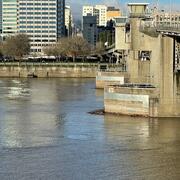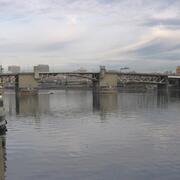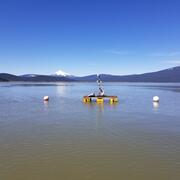Monitoring
Monitoring
Filter Total Items: 40
The “Super Monitor”: Tracking Willamette River water quality in Portland
Nicknamed the ‘Super Monitor,’ this site has measured key water-quality values every 15 minutes since 2009.
Measuring Willamette River streamflow in Portland
Learn about one of Oregon's most relied upon streamflow gages.
Willamette River Data Comes to Life Through Bridge Lighting
Did you know the colorful lighting on the Tilikum Crossing, Bridge of the People, is synced with U.S. Geological Survey water data from the Willamette River?
Integrating water availability in the Klamath Basin: from drought to dam removal
The USGS Water Resources Mission Area is assessing how much water is available for human and ecological needs in the United States and identifying where and when the Nation may have challenges meeting its demand for water. This information helps decision makers manage and distribute water in ways that balance competing needs. Due to its complex and competing water demands, ecological significance...
Evaluating sediment transport in Chicken Creek
The United States Geological Survey (USGS) is evaluating how the newly restored meandering channel on Chicken Creek affects sediment transport within the Tualatin River National Wildlife Refuge.
Bridge scour monitoring in Oregon
The U.S. Geological Survey is working with the Oregon Department of Transportation (ODOT) and Federal Highway Administration (FHWA) to revolutionize bridge scour monitoring using real-time sonar data collection and bathymetric surveying to remotely monitor sites, collect long-term data for evaluation, and develop and improve hydraulic models that predict scour.
Fern Ridge Geomorphology
The USGS, in cooperation with the U.S. Army Corps of Engineers (USACE), is conducting targeted research to better understand geomorphic conditions and processes within the reservoir at Fern Ridge Lake, near Eugene, Oregon, so that managers have the information to support dam operations and other actions that will aid in the preservation and management of cultural sites.
New gages for understanding surface water availability and spring Chinook salmon habitat in the Willamette Basin
Learn about our new streamgages in the Williamette River Basin.
Integrated Water Science Basins: Willamette River
The Willamette River Basin reflects the conflicting water demands between humans and ecosystems—particularly salmon— and the challenge resource managers face throughout the Pacific Northwest.
Upper Klamath Basin Groundwater Studies
Since the late 1990s, USGS has worked to characterize the regional groundwater hydrology of the upper Klamath Basin. Research focuses on collecting data to evaluate the groundwater system and its response to external stresses, and to develop computer models that provide insights for water management. These efforts build on earlier USGS studies going back to the 1950s.
Water-quality monitoring during reservoir drawdowns
The USGS is monitoring water-quality above, within, and below Middle Fork Willamette and the South Santiam River dams to understand how reservoir drawdowns influence downstream water-quality conditions.
Harney Basin Groundwater Study
In response to increasing groundwater demand and declining groundwater levels in the Harney Basin of southeastern Oregon, the U.S. Geological Survey and Oregon Water Resources Department conducted a groundwater-availability study during 2016–22. Read to learn about the key findings













